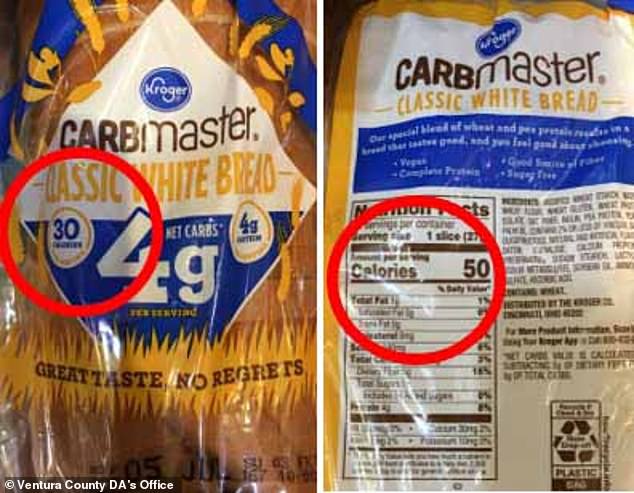Your favorite snack may contain more calories than you think.
This month, a lawsuit filed in California against Kroger alleged false advertising after prosecutors discovered that its ‘Carbmaster’ bread claimed to contain 30 calories per slice on the front of the packaging but 50 calories per slice on the back.
It’s just the latest of more than a hundred mislabeling lawsuits filed each year, with previous cases including a 300-calorie Chipotle burrito that turned out to have nearly 800 calories and a 50-calorie hamburger bun that actually had 100 calories.
Dr. Susan Roberts, who researches food labels at Dartmouth College in New Hampshire, said she was not surprised by the cases of mislabeling.
“It’s almost impossible to control all of these (labels),” he said. “We rely heavily on the honesty of food companies.”
The image above shows the front of Kroger’s Carbmaster bread and then the back, both offering different calorie counts per slice.


Others that will face lawsuits over calorie counting include Chipotle, which previously announced that its chorizo burrito had 300 calories. The company said this was a mistake, since the 300 referred to only the chorizo in the burrito, being actually about 800 calories in total.
The expert told Los Angeles Times That the problem is largely because the FDA allows food companies to choose from several different methods of calculating calories, with some being more reliable than others.
A calorie is a unit of energy, which the body needs every day to carry out vital functions such as breathing, circulating blood and performing physical activity.
The average man is recommended to consume around 2,600 calories per day, while the average woman is recommended to consume around 2,000 calories.
Ventura County District Attorney Erik Nasarenko, who brought the case against Kroger, said: ‘Consumers depend on nutritional information to make important decisions about their personal health and well-being. For some consumers, these decisions are based on medical necessity.
“Deceptive calorie advertising can mislead or even endanger consumers and provides an unfair advantage over competitors who advertise in accordance with FDA guidelines.”

Others facing proposed actions over lawsuits included Utah-based Crumbl Cookies. One of their cookies was equivalent to four servings, or 760 calories.
The lawsuit alleges that Kroger falsely advertised the calorie content of its ‘Carbmaster’ bread from November 2018 to June 2022.
During that time, the front of the package prominently displayed a calorie number per slice that was 20 calories less than advertised on the back.
In another case, Kroger’s hamburger buns were labeled 50 calories per serving on the front, even though the back said each one contained 100 calories.
To calculate calorie content, the FDA recommends that manufacturers use the Atwater system.
This assigns specific values to macronutrients (carbohydrates, protein, fat and alcohol) to calculate calorie content.
These are four calories per gram of carbohydrates, four calories per gram of protein, nine calories per gram of fat, and seven calories per gram of alcohol.
Other labeling class action lawsuits have been proposed against manufacturers such as Crumbl Cookie, a Utah gourmet cookie maker.
The proposal said Crumbl was misleading customers by advertising that one serving of its cookies was equivalent to 190 calories, and that each cookie sold by the company was actually four servings or the equivalent of 760 calories.
In 2020, more than 100 lawsuits were filed alleging false labeling, a category that includes accusations of understating or exaggerating calorie counts, as well as misstating portion sizes or claiming that foods were prepared in a certain way, such as smoked. .
In a previous class action lawsuit filed in 2016 against Chipotle, customers complained about the 300-calorie chorizo burrito after saying it left them full afterwards.
They then calculated that the burrito probably contained 1,050 calories in total, more than three times the advertised figure.
Chipotle later apologized for the error and said the 300-calorie unit referred to chorizo only.


